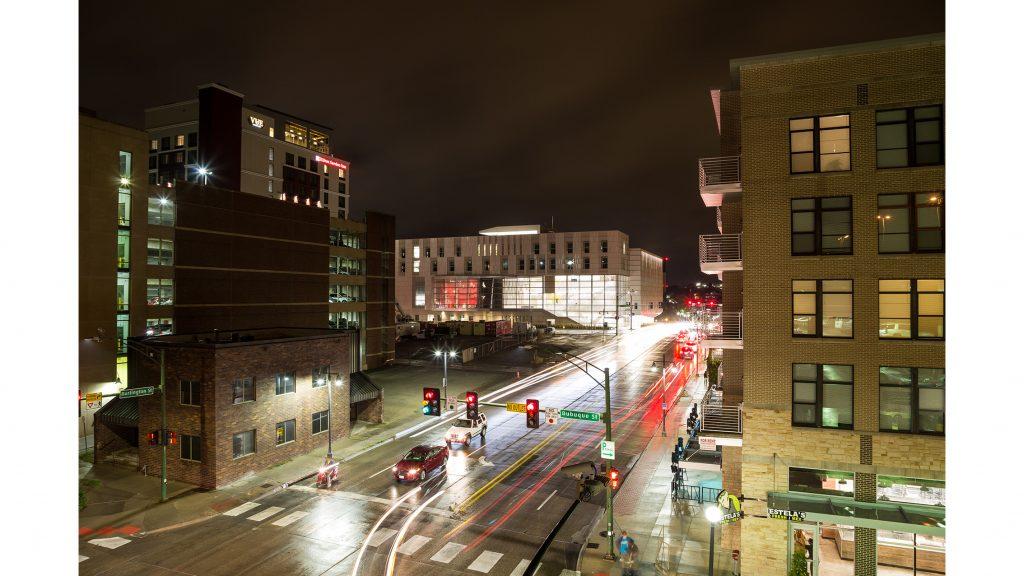Weigel: Lack of infrastructure holds city back
It’s tempting to say Iowa City is a city, but numerous transportation and infrastructure deficiencies are holding it back. Nonetheless, Iowa City may be on its way to becoming a city if transportation infrastructure can catch up to development.
David Harmantas/The Daily Iowan
The corner of Dubuque and Burlington streets at night on Friday, Oct. 6, 2017. (David Harmantas/The Daily Iowan)
September 19, 2018
Is Iowa City a city? Given Einstein’s Theory of Relativity, if you’re like me and grew up in a small town, then chances are you probably would consider Iowa City a city. After all, the population of the metro area — Iowa City, Coralville, North Liberty, etc. — is well north of 100,000 people. Not to mention, the word city is literally part of Iowa City’s moniker.
Yet, if you are accustomed to a more urban scene, say, Chicago or Des Moines, it’s likely that you might think twice about calling Iowa City a true city.
Anyway, setting aside culturally relative semantic definitions, in traveling to more urban areas, I’ve come to conclude that Iowa City isn’t a city because of its lack of transportation infrastructure.
Take, for example, Chicago. You’d be hard-pressed to find anyone willing to argue that the nation’s third largest metro area isn’t a city. One thing that sets Chicago apart from Iowa City is the significantly more advanced transportation infrastructure. In Chicago, you can get around by bus, train, taxi, ride-share, carriage, bike, and even boat. What’s more, there’s an international airport that puts you within a few hours’ access of nearly any destination in the world.
Now let’s look at Iowa City in comparison. Yes, there is bus service in Iowa City but it is a bit disparate. There is certainly room for improvement by unifying the routes and stops of city and university buses. And yes, you can technically get a taxi or Uber/Lyft in Iowa City, but it can be difficult to do so at times because of a lack of drivers. There’s also no passenger rail service, and there are few long-distance bus routes that traverse through Iowa City. Plus, while there is an airport, it’s not commercial, so you have to trek around 20 miles north to nearly Cedar Rapids to have a chance at getting a flight to your desired destination.
RELATED: Iowa City looks to fight flash flooding with new pump system
However, despite deficiencies in terms of transportation, perhaps the biggest thing holding Iowa City back from being a real city are the roadways and lack of parking. I-80 and I-380 are super convenient for quickly getting around the state, but the streets in Iowa City make getting around town a bit of a hassle. For instance, take Burlington Street, Gilbert Street, Riverside Drive, or Highway 1. They are all four-lane roads, but they do not have bike lanes, and they have insufficiently sporadic turn lanes.
And then there’s everybody’s favorite rallying cry against Iowa City — the severe scarcity of parking.
Therefore, although it’s tempting to say Iowa City is a city, at present, I don’t think it is. But, Iowa City may be on its way to becoming a city if transportation infrastructure can catch up to commercial and housing development.
Over the last few decades, the population of the metro area and of the university have continued to grow, but the infrastructure to accommodate the influx of people has lagged. Per the Iowa City City Council’s fiscal 2018-2020 financial plan, Iowa City is one of the best-run municipalities in the state with excellent financial standing. It is understandable that Iowa City’s infrastructure is lacking because the tremendous toll the 2008 flood had on the area, but now is the time for Iowa City to ramp up transportation and infrastructure investment with available funds and/or consider finding ways to finance more capital projects through other channels.
Putting a freeway in the middle of downtown or dichotomizing Iowa Avenue into an upper and lower like Upper and Lower Wacker Drive in Chicago may be going too far. But more pragmatic infrastructure investments such as consistent bike and turn lanes, a unified bus system, easier access to cross-country travel, and parking expansion would certainly help Iowa City attain the verifiable status of being a city.






